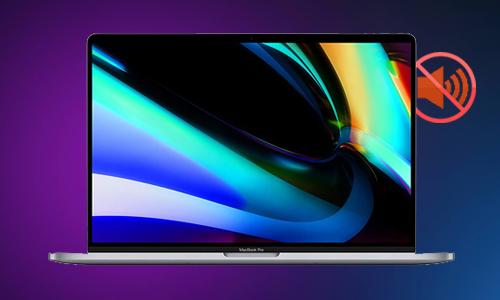How to fix the sound not working on the MacBook issue? So, after a long day, you finally settled for a movie or some music on your Mac. However, despite turning up all volume keys, you find yourself staring at your Mac’s screen without hearing anything. The audio output on your Mac will not work! I get how you feel: disappointed.
Take a look at these fast remedies to fix your Mac’s malfunctioning sound. Tired from a long day? You can take a nap and return to this post later for a quick remedy.
Table of Contents
How to fix the sound not working on the MacBook issue?

Here is the list to fix the sound not working on the MacBook issue:
Method #1. Check the volume control buttons
While this may appear silly, you may have inadvertently reduced the size of your Mac’s control button. Mistakes occur. Increase the volume on your computer while it is playing audio.
To do so, open the Control Center on your Mac and select the Sound icon. Then, if the slider is down, raise it.
Method #2. Play random music files to fix the sound not working on the MacBook issue
The sound quality of several tracks is bad. Worse, they may not play on your Mac. Furthermore, some music files may be incompatible with your Mac. If this is the case, they may not make a sound.
To investigate this issue, begin by playing random music files on your Mac to see if the sound works. To be sure, you can also listen to songs online.
If other songs work in addition to the one you’re attempting to play, you can delete and re-download that music file. Then try it again to check if it still works. Otherwise, your macOS may not recognise that file format.
Method #3. Speak to Siri to check Mac’s speakers
Speaking to Siri is one of the finest ways to put your Mac’s built-in speakers to the test. However, before using Siri, make sure you unplug any external audio devices from your Mac because it uses the system sound by default.
If you’ve previously enabled Siri on your Mac, doing this test is simple.
“Hey Siri, how are you?” you might say. If Siri responds audibly, your Mac’s audio hardware is in good working order. It could also be a software issue.
Method #4. Unplug external speakers or earphones
External speakers connected to your Mac may be faulty or improperly connected, preventing audio output from your computer. This may lead you to believe that your Mac’s audio output is defective when it is not.
Unplug them from your Mac to see if the issue is caused by external speakers. Then, test the built-in audio by playing any song or movie. Don’t jump to the conclusion that a system’s audio is faulty just yet. There are still a few things to look into.
Method #5. Ensure individual macOS app is not muted
Most apps, including games, provide volume controls. If you can’t hear anything when playing a game or streaming a movie or song through an app, it’s probably on silent.
If that’s the case, you won’t hear anything. So, before proceeding to the more technical adjustments, make sure you increase the volume in the app’s settings.
If your Mac’s audio still doesn’t function after you’ve tested the sound outputs as described above, it’s time to look into more technical alternatives. But don’t worry, these are simple.
Method #6. Select the right Audio device
If you pick the incorrect audio device in your system settings, audio may not work on your Mac. And most individuals experience this by accident. This is true whether you’re attempting to use external audio equipment such as speakers or earbuds.
To check and pick the correct audio device on a Mac, do the following:
- System Preferences can be accessed by clicking the Apple logo.
- Navigate to Sound.
- Navigate to Output.
- From the list, select the plugged-in audio device.
Method #7. Re-plug the external audio device to fix the sound not working on the MacBook issue
If your Mac’s audio output only stops working when you connect to an external audio device, this solution is for you.
Due to a variety of causes, the interface between a plugged-in external audio device and your Mac may be jittery. Unplugging and reconnecting the external audio device frequently helps. If you’re utilising Bluetooth audio devices, you’ll also want to troubleshoot Bluetooth device connectivity issues.
Finally, use a soft brush to clear debris from the speaker or headphone jack and USB ports. Reconnect the external audio equipment to see whether it works.
Method #8. Restart your Mac to fix the sound not working on the MacBook issue
Software issues, particularly RAM, may cause the audio device to freeze, preventing it from functioning normally. The majority of customers report that restarting their computer resolves the failed audio-output issue. Furthermore, restarting your Mac provides a new start and clears the clogged RAM.
To restart your Mac, click the Apple logo and select Restart. Playing sound on your Mac should cure the problem this time.
Method #9. Update your macOS to fix the sound not working on the MacBook issue
Many functions can be broken by an older macOS. Even though an outdated macOS does not directly affect audio, it may hinder some apps from running properly on your Mac. This may have an impact on native functionality such as in-app system loudness. The remedy is straightforward: upgrade your macOS. Then, try playing a song or a movie to see if the sound on your Mac works this time.
Method #10. Reset your Mac’s NVRAM
NVRAM is an abbreviation for non-volatile random access memory. The memory keeps your Mac’s settings for easy access. This memory employs a dedicated CMOS battery that keeps it operational even when your Mac is turned off. It assists Mac in recovering prior settings when the system boots.
If it stops working or becomes faulty, it may have an impact on important aspects of your Mac’s settings, including the audio settings. Fortunately, resetting the NVRAM is simple. It aids in restarting this memory unit and restoring it to its previous settings.
Method #11. Restart the sound controller to fix the sound not working on the MacBook issue
If you’ve tried all of the following methods and your Mac has no peripherals connected, it’s time to restart the sound controller.
Go to Activity Monitor and type coreaudiod. Quit the activity by clicking on it. After that, the sound controller will restart on its own.
Method #12. Reset Mac’s core audio interface
The application programming interface (API) that powers audio output within your Mac’s programmes is known as core audio. As a result, developers utilise it to write the audio components of hybrid Mac apps. As expected, if it breaks or becomes problematic, apps cannot emit sound.
But you can’t tell if it’s the culprit. However, for most folks, simply resetting the core audio via your Mac’s CLI works.
To reset Mac’s core audio API, use the terminal and enter:
sudo killall coreaudiod
Method #13. Contact Apple Support
If nothing else works, it’s time to contact Apple Support. Speaking with an Apple representative may help you resolve sound output since it will provide you with a better understanding of what is wrong with your Mac.
It’s aggravating when your Mac’s audio doesn’t work. You’ve put so much into it, and you deserve the finest it has to offer. However, audio failure occurs – even on the greatest Mac systems. I’ve highlighted simple solutions to the audio output problem on your Mac machine. It might only need a few tweaks to make it function.




